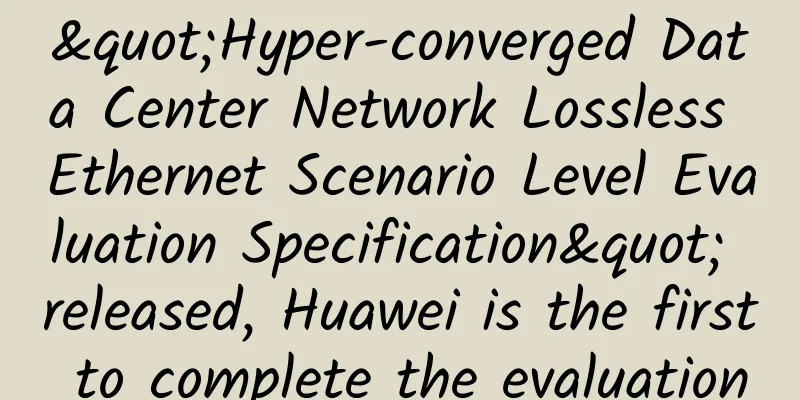"Hyper-converged Data Center Network Lossless Ethernet Scenario Level Evaluation Specification" released, Huawei is the first to complete the evaluation

|
The "2021 Open Data Center Summit" was held in Beijing from September 15 to 16. In the release of the results of the ODCC Summit on September 15, the "Hyper-converged Data Center Network Lossless Ethernet Scenario Level Evaluation Specification" was released. The level evaluation specification was jointly drafted and released by the China Academy of Information and Communications Technology (Cloud Computing and Big Data Research Institute), Huawei Technologies Co., Ltd., China Mobile Research Institute, Beijing Jingdong Century Trading Co., Ltd., Industrial and Commercial Bank of China Data Center, Broadcom, Keysight Technologies (China) Co., Ltd., and Spirent Communications. How to download the Hyper-converged Data Center Network Lossless Ethernet Scenario Level Evaluation Specification With the widespread deployment of mobile Internet, big data, cloud computing, blockchain and other related applications, as well as the rise of strong experience applications such as 5G intelligent industrial control, HPC simulation verification, and AI risk control in data centers, data centers have become the commanding heights of traffic and business in the digital economy era. Hyper-converged data center networks are designed to provide converged and lossless interconnection for cloud data centers. The current standards for lossless Ethernet networks in data centers are becoming more mature, but the industry does not yet have relevant performance grading and evaluation specifications, and the quality of lossless Ethernet networks cannot be uniformly evaluated. Therefore, a unified performance grading and evaluation specification is urgently needed to standardize the deployment and use of lossless Ethernet networks in data centers. The grade evaluation specifications released this time are based on distributed storage scenarios, centralized storage scenarios, and high-performance computing scenarios, and are evaluated from five dimensions: function, performance, reliability, compatibility, and operation and maintenance. A score of 0-5 is given to each sub-scenario and the corresponding five dimensions according to the evaluation criteria. The weighted calculation is then used to define the grade of the lossless Ethernet network, which is currently divided into five levels: L1 (lossless capability is not yet mature, and performance is low), L2 (basic lossless capability), L3 (mature lossless capability), L4 (good lossless capability), and L5 (excellent lossless capability). The official release of this level evaluation specification marks the maturity and standardization of the testing, application and deployment of lossless Ethernet networks, and also points out the direction for the development and application of lossless Ethernet network technology. As a pioneer on the road of hyper-convergence, Huawei launched the hyper-converged data center network CloudFabric 3.0 in March. Based on a three-layer converged architecture, it can help data flow and process efficiently, release computing power 100%, and build a solid computing power foundation for the digital economy and enterprise digital transformation. At the same time, as a major contributor to the evaluation specification, Huawei also took the lead in simultaneously entrusting the China Academy of Information and Communications Technology to evaluate Huawei's data center full lossless Ethernet network solution according to the level evaluation specification. Through the test of 50+ indicators, Huawei's full lossless Ethernet network solution scored 3.5, 3.8 and 3.3 in the three major scenarios of distributed storage, centralized storage, and high-performance computing (HPC), respectively, and scored 3.5 points overall, indicating that Huawei's hyper-converged data center network full lossless Ethernet network solution can meet the mature commercial needs of various scenarios. Since its launch, Huawei's hyper-converged data center lossless Ethernet solution has been used in many joint innovations and commercial deployments in industries such as finance, operators, and large enterprises. Looking to the future, Huawei will continue to work with industry partners to actively promote the promotion and development of lossless Ethernet network scenario evaluation, create a new pattern for the development of lossless Ethernet networks, and make more contributions to accelerating the digital transformation of enterprises. |
<<: Is 5G connectivity the future of IoT?
Recommend
Huawei Cloud releases blockchain white paper to accelerate the implementation of blockchain technology in the industry
On April 17, during the 2018 Huawei Analyst Confe...
What exactly is HTTP3 that international companies such as Google are beginning to support?
There has been a lot of news about HTTP/3 in rece...
NTT and Cisco team up to provide integrated collaborative communications solutions
NTT and Cisco jointly provided an integrated coll...
HostingViet: 35% off for annual VPS/virtual hosting in Vietnam, 35% off for new purchases of Email Server
HostingViet's April promotion will end in two...
ZJI Golden Autumn Brings Coolness: 40% off on Hong Kong Kwai Wan High Defense Servers, 32% off on designated models in Hong Kong Tai Po
ZJI has launched the second wave of its September...
Solutions for 5G Network Security Threats
With the support of artificial intelligence techn...
Wi-Fi 6 certification, here are 6 issues worth paying attention to!
This article is reproduced from Leiphone.com. If ...
Payment platform: detailed explanation from gateway layer to data analysis layer
1. Payment architecture process 1. Gateway layer ...
What are the remaining obstacles to China's 5G?
With the news that Nokia and Ericsson won the bid...
These four routers are the most worth buying during the shopping festival, covering all high, medium and low end
[[432368]] This year's 11.11 Shopping Festiva...
How to explain network engineering technologies such as STP, HSRP, etc. in a simple and understandable way?
During an interview, for example, I was asked abo...
China’s 5G leads the world!
[[414223]] This article is reprinted from the WeC...
5G is not yet popular, so why are 4G phones now starting to have their speed limited?
I don’t know since when, but it feels like the cu...
Introduction to SDN Controller
1. Introduction to SDN and controller SDN (Softwa...
HostHatch 12th Anniversary, Hong Kong 1TB large hard drive from $35/year
HostHatch launched a promotional campaign for its...









